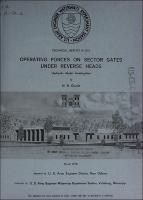Please use this identifier to cite or link to this item:
https://hdl.handle.net/11681/13504Full metadata record
| DC Field | Value | Language |
|---|---|---|
| dc.contributor | United States. Army. Corps of Engineers. New Orleans District | - |
| dc.contributor.author | Oswalt, Noel R. | - |
| dc.date.accessioned | 2016-07-18T15:34:00Z | - |
| dc.date.available | 2016-07-18T15:34:00Z | - |
| dc.date.issued | 1970-03 | - |
| dc.identifier.uri | http://hdl.handle.net/11681/13504 | - |
| dc.description | Technical Report | - |
| dc.description | Abstract: Several sector gate locks in southern Louisiana (Bayou Boeuf, Freshwater, and Calcasieu) have experienced operational difficulties during reverse heads of 1.0 ft or greater. A 1:20-scale model with one set of gate leaves was constructed to measure forces acting on sector gate during reverse heads, develop feasible modi fications for elimination of stall at existing structures, and test a gate of new design for use in future structures . Observation of free gate novement (original Bayou Boeuf gate revealed forces tending to resist opening of the gate under reverse head ccnditions and to open the gate under normal head conditions. Model force measurements were made using a ±20-lb load cell rigidly connected to the center of a free gate leaf on a tangent and 42.5 ft from the pintle. The opposite gate leaf was wedged at the desired opening. During most tests a 12-ft depth of water was maintained on the lower pool side of the gate, while head differentials up to 18 ft were tested for gate openings from 1 to 10 ft. Forces tending to resist opening of the type 1 gate under reverse heads were approximately seven times greater than the design force for a normal head. Head differentials across the members of the gate near the nose of each leaf probably caused a major portion of the load on the gate machinery. Types 2 , 3, and 4 modifications designed to reduce head differentials across these members were tested. The type 2 gate which involved removal of the skin-plate lip closure gave the greatest force reduction for the least prototype change. Tests also demonstrated the degree of further reduction of reverse head forces that could be realized by use of shorter seal brackets attached to the skin plate of each leaf for sealing at the lock walls. Brackets 4-in. long were ccnsidered the minimum feasible. Forces on a new sector gate designed by the New Orleans District were found to be only about 20 percent of forces on the existing gates. | - |
| dc.publisher | Hydraulics Laboratory (U.S.) | - |
| dc.publisher | Engineer Research and Development Center (U.S.) | - |
| dc.relation | http://acwc.sdp.sirsi.net/client/en_US/search/asset/1034268 | - |
| dc.relation.ispartofseries | Technical report (U.S. Army Engineer Waterways Experiment Station) ; H-70-2. | - |
| dc.rights | Approved for public release; distribution is unlimited. | - |
| dc.source | This Digital Resource was created from scans of the Print Resource | - |
| dc.subject | Hydraulic models | - |
| dc.subject | Hydraulic structures | - |
| dc.subject | Lock gates | - |
| dc.subject | Reverse head | - |
| dc.subject | Head waves | - |
| dc.subject | Fluid mechanics | - |
| dc.subject | Sector gates | - |
| dc.title | Operating forces on sector gates under reverse heads : hydraulic model investigation | - |
| dc.type | Report | en_US |
| Appears in Collections: | Technical Report | |
Files in This Item:
| File | Description | Size | Format | |
|---|---|---|---|---|
| TR-H-70-2.pdf | 2.91 MB | Adobe PDF |  View/Open |